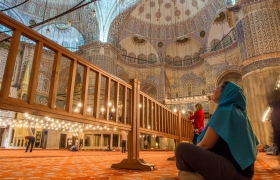Latest topics
The problem of medieval villages and earthquakes
2 posters
Page 1 of 1
 The problem of medieval villages and earthquakes
The problem of medieval villages and earthquakes

In Japan and California, they’ve spent billions on state-of-the-art earthquake and tsunami preparedness schemes. In poorer countries like Nepal, Haiti, and Indonesia, they’ve resettled survivors in less quake- or flood-prone areas. But Italy presents a fairly unique challenge for earthquake engineers: how do you make historic, medieval towns and villages safer without knocking the whole lot down?
Precariously perched along the spine of the Apennine mountain range, villages like Amatrice that were destroyed by Wednesday’s earthquake are cultural jewels, set in some of Europe’s most beautiful and unspoiled landscapes. You’re not going to stop people wanting to live there; you’re not going to prevent tourists from visiting; and the tectonic activity is unlikely to cease any time soon.
All you can do is try to mitigate the damage, try to keep the toll as low as possible. A strict building code is clearly a good place to start, but Italy already has one of the most stringent in the world.
In 2002, a moderate earthquake in relatively safe seismic territory – Modena, east of Rome – led to the collapse of a primary school in the town of San Giuliano di Puglia. A teacher and 27 primary school children, including an entire year group, died. An exhaustive seismic remapping followed and a new building code was drawn up based on Europe’s existing code, but adding even tighter restrictions. It took effect in July 2009, due to public pressure following the L’Aquila earthquake that claimed more than 300 lives in April of that year.
So why, if Italy has such a stringent building code, did so many people die – 267 and counting – in Wednesday’s earthquake, and why will people continue to be at risk the next time a similar seismic event rocks the picturesque Apennine region?
The old and the new
A cursory glance at the images tells you a great deal: many of the dead were sleeping in homes constructed centuries before building codes even existed.“The law that was enforced after 2009… it’s a code that only deals with construction and renovation,” Michele Calvi, a professor of earthquake engineering at IUSS Pavia, told IRIN. “So, [there’s] no obligation to do anything if you’re keeping the building as it is.”
Advances in construction and technology have resulted in modern structures that can better withstand the impact of earthquakes. But there were also reports of some modern buildings collapsing, including a hospital, a police station, and a school, raising questions about the hundreds of millions of euros allocated for seismic retro-fitting following L’Aquila."What should be done is to create very significant incentives for people to spend money retro-fitting these buildings"
“Obviously the buildings weren’t all retro-fitted,” Brigitte Leoni, communications officer with the UN’s Office for Disaster Risk Reduction, told IRIN. “You need to do a risk assessment and evaluate your priorities – usually the critical infrastructures like hospitals are first priority. In Italy, they’re aware of it, and compared to other countries they’re really well advanced, but they have a lot of old buildings. After 2009, this was a measure they increased [retro-fitting], but it can’t be 100 percent.”
What can be done?
“There is not a safe and unsafe building. It’s just what you can do to decrease the possibility of collapse,” said Calvi, explaining that different prescriptions apply to different types of structure.“When you’re dealing with a stone building, like most of these in this area, you can look at minor things like the connection between different floors and the walls, elimination of any structure that’s pushing against it, like arches. It’s not very expensive at all to do these things.”
For more modern, concrete buildings, Calvi suggested the addition of diagonal ties to take care of horizontal forces, the cutting of columns, and the insertion of seismic isolation units.
The cash-strapped Italian government doesn’t have the wherewithal to pump billions of euros into earthquake preparedness. It did commit 965 million euros over seven years to seismic prevention following L’Aquila, but this is a drop in the ocean compared to the infrastructure needs of thousands of remote, historic villages.
Following the latest disaster, Prime Minister Matteo Renzi has pledged 50 million euros for rebuilding and announced a new initiative, "Italian Homes", to bolster best practice in construction.
Private or public responsibility?
Discover More

Does Countering Violent Extremism work?
Given the number of these villages and their rapid depopulation, disasters like L’Aquila and Amatrice have profound cultural implications for the region.
ICCROM, a Rome-based intergovernmental agency dedicated to the preservation of cultural heritage, is liaising with Italy’s culture ministry and civil protection department to see how it can help in terms of technical assistance, crisis mapping, and rapid assessment.
Paul Arenson, ICCROM’s manager of knowledge and communication services, pointed out the distinction between private ownership and public buildings.
Unless somewhere is listed by UNESCO as a World Heritage Site, in which case special protection protocols apply, the onus is on the local municipality or the individual owner to ensure their properties abide by the national building code.
Calvi said the areas hit on Wednesday were largely inhabited by elderly people on relatively low incomes or consisted of holiday homes, so there was little motivation for the owners to do anything – and it was no surprise that most of the buildings hadn’t been retro-fitted.
“What should be done is to create very significant incentives for people to spend money retro-fitting these buildings,” he told IRIN. “In most countries, including Italy, there’s no such policy. Considering that the state pays most of the costs of rebuilding after an earthquake, it would make sense to do this. I’ve tried to recommend this many times but people aren’t interested until the earthquake comes. In a few months, no one will be interested in these issues anymore.”
For ICCROM conservation specialist Alison Heritage, the technologies exist and the building codes, at least within Europe, are very vigorous, so it boils down to implementation and awareness.
“Now that comes down to an issue of coordination, most probably at the level of the municipalities,” she said. “But it also really does come down to an issue of public awareness, awareness of risk, and whether or not it is necessary to have an additional seismic check taken out on your building.”
What else can be done?
But it’s not simply a question of improving the earthquake-resistance of buildings. This latest disaster highlighted the need for better preparation generally: from education to regular emergency evacuation drills, to having rubble-clearing equipment close by.
“In one of the villages, the mayor was organising the search-and-rescue from a square because there was no building left that was safe enough for this purpose,” said Calvi. “Even the municipal building wasn’t safe enough. Suppose it had been raining?”
“In places like this that are in high areas, there should be more knowledge about how many people are there,” he added.

USGS
How the shaking spread out across the Apennines
Enzo Boschi, an expert in seismology at the University of Bologna, saw proof of what is needed in the Umbrian town of Norcia, which lies near the epicentre of Wednesday’s quake.
“There was an earthquake there in 1979, which led to seismic protection being carried out on the buildings,” he told the Italian Insider. “As a result, the town was practically unscathed by last night’s quake.”
“We are good at constructing seismic-protected buildings, but only after an earthquake occurs,” he commented.
Calvi agreed, saying: “I think this country is relatively well-organised in terms of what to do after an earthquake. I think what needs improving is what to do before.”
(Additional reporting by Kristy Siegfried)
08.27.2016
By Andrew Gully
http://www.irinnews.org/analysis/2016/08/26/problem-medieval-villages-and-earthquakes

Ponee- Admin

- Posts : 38267
Join date : 2011-08-09
 Re: The problem of medieval villages and earthquakes
Re: The problem of medieval villages and earthquakes
Very interesting...... Remind me to never visit there.....
I remain,
Just4Tom74







I remain,
Just4Tom74

Just4Tom74- VIP Member

- Posts : 833
Join date : 2016-08-07
Age : 81
Page 1 of 1
Permissions in this forum:
You cannot reply to topics in this forum

» Go Russia
» I am too pretty for math, but....
» Interesting article
» Phony Tony: New Platform, same old song and dance
» The Craziness of Scam by "Tony TNT Renfrow" and the Iraqi Dinar Currency Scam
» Even conspiratorial currency speculators aren’t buying a Russian ruble revalue - It’s not the next the Iraqi dinar
» The Fundamentals of Finance and Pimpy Live
» Carnival Rides
» Go Russia
» Textbook Tony
» The Rockefellers and the controllers are freaking out right about now
» Phony Tony sez: Full Steam Ahead!
» Dave Schmidt - Zim Notes for Purchase (NOT PHYSICAL NOTES)
» Russia aren't taking any prisoners
» Deadly stampede could affect Iraq’s World Cup hopes 1/19/23
» CBD Vape Cartridges
» Classic Tony is back
» THE MUSINGS OF A MADMAN
» Minister of Transport: We do not have authority over any airport in Iraq